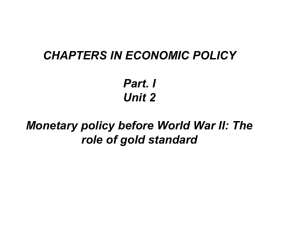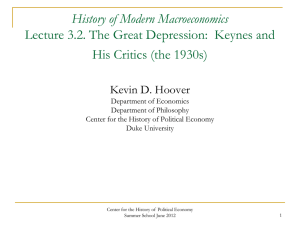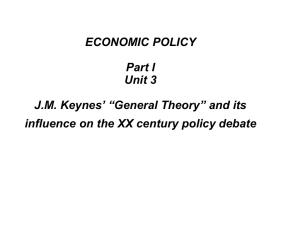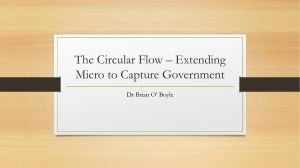Eckalbar Understanding Chapter 2 of the General Theory
advertisement
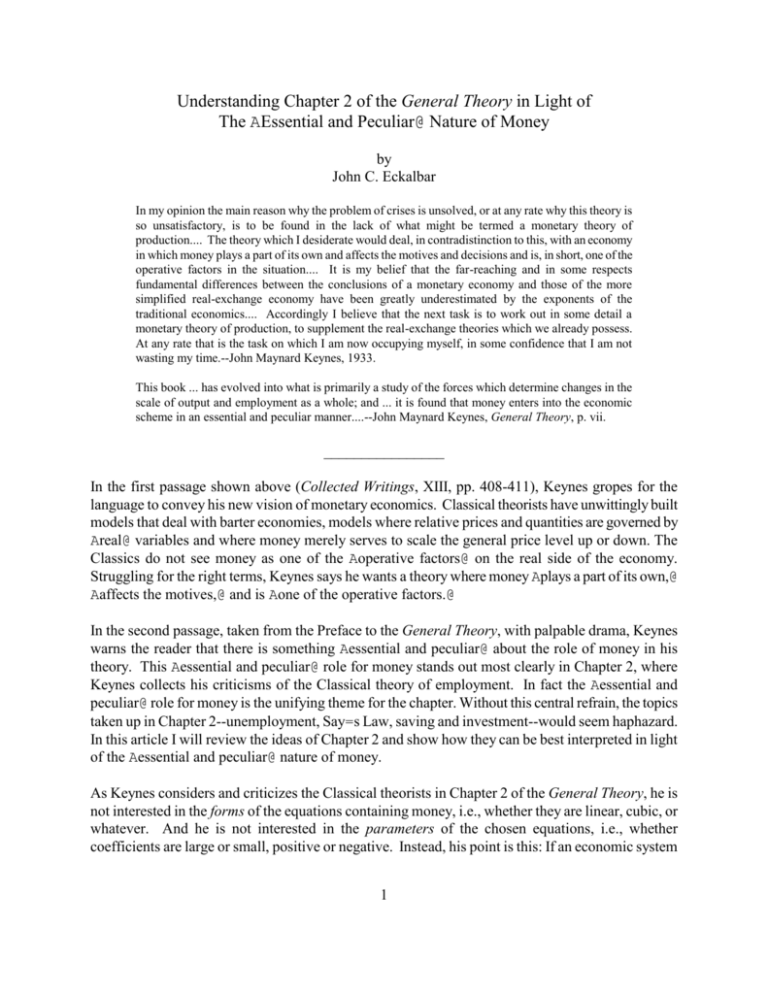
Understanding Chapter 2 of the General Theory in Light of The AEssential and Peculiar@ Nature of Money by John C. Eckalbar In my opinion the main reason why the problem of crises is unsolved, or at any rate why this theory is so unsatisfactory, is to be found in the lack of what might be termed a monetary theory of production.... The theory which I desiderate would deal, in contradistinction to this, with an economy in which money plays a part of its own and affects the motives and decisions and is, in short, one of the operative factors in the situation.... It is my belief that the far-reaching and in some respects fundamental differences between the conclusions of a monetary economy and those of the more simplified real-exchange economy have been greatly underestimated by the exponents of the traditional economics.... Accordingly I believe that the next task is to work out in some detail a monetary theory of production, to supplement the real-exchange theories which we already possess. At any rate that is the task on which I am now occupying myself, in some confidence that I am not wasting my time.--John Maynard Keynes, 1933. This book ... has evolved into what is primarily a study of the forces which determine changes in the scale of output and employment as a whole; and ... it is found that money enters into the economic scheme in an essential and peculiar manner....--John Maynard Keynes, General Theory, p. vii. ________________ In the first passage shown above (Collected Writings, XIII, pp. 408-411), Keynes gropes for the language to convey his new vision of monetary economics. Classical theorists have unwittingly built models that deal with barter economies, models where relative prices and quantities are governed by Areal@ variables and where money merely serves to scale the general price level up or down. The Classics do not see money as one of the Aoperative factors@ on the real side of the economy. Struggling for the right terms, Keynes says he wants a theory where money Aplays a part of its own,@ Aaffects the motives,@ and is Aone of the operative factors.@ In the second passage, taken from the Preface to the General Theory, with palpable drama, Keynes warns the reader that there is something Aessential and peculiar@ about the role of money in his theory. This Aessential and peculiar@ role for money stands out most clearly in Chapter 2, where Keynes collects his criticisms of the Classical theory of employment. In fact the Aessential and peculiar@ role for money is the unifying theme for the chapter. Without this central refrain, the topics taken up in Chapter 2--unemployment, Say=s Law, saving and investment--would seem haphazard. In this article I will review the ideas of Chapter 2 and show how they can be best interpreted in light of the Aessential and peculiar@ nature of money. As Keynes considers and criticizes the Classical theorists in Chapter 2 of the General Theory, he is not interested in the forms of the equations containing money, i.e., whether they are linear, cubic, or whatever. And he is not interested in the parameters of the chosen equations, i.e., whether coefficients are large or small, positive or negative. Instead, his point is this: If an economic system 1 uses money as a medium of exchange, then the equations which govern its behavior are fundamentally different from those which govern a barter system--even the equations that do not contain the money variable. One does not model a money-exchange economy by building a barter model and tacking on a few extra equations for money. Instead the whole layout of the moneyexchange model must be fundamentally different. But rather than grope for words to express the generalities, let us get to the particulars. Classical Postulates I and II In the Preface and again in Chapter 1, Keynes tells us that the problems with classical economics lie with the assumptions or postulates, not with the analysis that follows from the assumptions. In Chapter 2 Keynes picks through the Classical theory of employment looking for the critical assumptions. According to Keynes, the Classical theory of employment derives from two principal assumptions: Classical Postulate I assumes, AThe wage is equal to the marginal product of labour.@ (Collected Writings, VII, p. 5) And Classical Postulate II assumes, AThe utility of the wage when a given volume of labour is employed is equal to the marginal disutility of that amount of employment.@ (Collected Writings, VII, p. 5) Stated more directly, Classical Postulate I simply means that the system is on the conventional labor demand curve, and Classical Postulate II means that the system is on the labor supply curve. If both assumptions hold, then we must be at a fullemployment equilibrium. As is so typical of Keynes, he is careless in his use of terms. When he says Awage,@ it is clear from later text that he intends Areal wage.@ For example, immediately following Postulate II, we read, AThat is to say, the real wage....@ (Collected Writings, VII, p.5) If Classical Postulates I and II are true, it would follow that employment fluctuations are due entirely to shifts in the marginal product (demand) for labor or in the supply of labor. Examples of such factors are given on page 7 of the General Theory. At this point Keynes offers two observations, the first of which is Anot theoretically fundamental, but the second of which is fundamental.@ (Collected Writings, VII, p. 8) His first (not fundamental) observation is this: the Classicals assume that labor supply is a function of the real wage alone, which we can write as Ls(w/p). Keynes argues that this cannot be so, since there is an asymmetry in workers= reactions to changes in w versus changes in p. If workers cared only about w/p, then this asymmetry would not exist. His point is that workers react differently to a cut in nominal wages than to an equivalent rise in prices. They resist nominal wage cuts, and they acquiesce to price increases. ( See Leijonhufvud, pp. 81ff.) His second objection is more fundamental--workers and employers may find it impossible to get onto the labor supply curve, even if they try. As a preliminary to looking into Keynes fundamental objection, I will concoct two illustrative examples that Keynes does not bring up in the General Theory. Here is an unconventional example that illustrates the general principal behind a recurring theme in Chapter 2. In Figure 1 we see the yearly demand and supply for beer drawn as functions of the 2 annual rainfall. The demand curve slopes downward, since hot dry days lead to increased beer demand, and cool rainy days lead to consumption of beer substitutes. The supply curve slopes upward, because increased rainfall means cheaper and more plentiful hops, rice, and other ingredients. Does it follow from this that rainfall is determined by the demand and supply for beer? Of course not. Just because we can draw two curves in the same space, it does not follow that the value of the variable on the vertical axis is determined by the intersection of the two curves. In the words Keynes uses later in the chapter, there may be no Anexus,@ no connection between the dynamics of the variable measured on the vertical axis and the positions of curves drawn in the figure. (In a perfectly functioning competitive beer market, if demand were greater than supply at the current rainfall rate, the price of beer would rise and the curves in Figure 1 would shift until they intersected at the current rate.) Our second example comes closer to Keynes= writing in Chapter 2, but is still not there explicitly. Consider the following plantation-economy model. Labor and coconuts are the only items traded. Workers offer their labor services to the owners of the plantations, and they demand coconuts in compensation. The owners hire workers and hope to keep a coconut profit by paying workers less than their total product. If we assume diminishing marginal returns to labor and an up-going labor supply curve, we can draw Figure 2, which shows labor demand and supply as functions of the Areal wage,@ which is in units of coconuts per hour. Suppose that for some reason the current real wage is 10 coconuts per hour and (due to short-side dominance) employment is L0. There is unemployment of L1 - L0. The reservation wages of the various unemployed workers locate them randomly on the SL curve, but we can be sure that there are some workers who would prefer to work at a wage near 6 coconuts per hour rather than sit idle. At the same time, the owners would gladly hire an extra worker as long as the worker would accept less than his marginal product of about 10 coconuts per hour. If all mutually advantageous trades are exhausted, the system moves to a real wage of 8 coconuts per hour and a full-employment level of LE. Three observations: (i) If the workers refused to accept less than 10 coconuts per hour, there would be unemployment of L1 - L0, but it would be Avoluntary unemployment.@ (ii) Supply creates its own demand in the sense that the offer of labor by workers is a demand for coconuts. The owner does not have any uncertainty with respect to paying the worker and then discovering that the worker=s output cannot be sold--the worker wants a fraction of his own output, and the owner is desirous of what is left over after the worker is paid. (iii) The bargaining between the workers and the owner directly concerns the variable measured on 3 the vertical axis (coconuts), and between them, the workers and the owner have control over this variable. We now return to Keynes= second objection. Keynes= Amore fundamental@ objection to Classical Postulate II is this: The second postulate flows from the idea that the real wages of labour depend on the wage bargains which labour makes with the entrepreneurs.... Thus the classical theory assumes that it is always open to labour to reduce its real wage by accepting a reduction in its money-wage.... [T]he other, more fundamental, objection, which we shall develop in the ensuing chapters, flows from our disputing the assumption that the general level of real wages is directly determined by the character of the wage bargain.... For there may be no method available to labour as a whole whereby it can bring the wagegoods equivalent of the general level of money-wages into conformity with the marginal disutility of the current volume of employment. There may exist no expedient by which labour as a whole can reduce its real wage to a given figure by making revised money bargains with the entrepreneurs. This will be our contention. We shall endeavor to show that primarily it is certain other forces which determine the general level of real wages. The attempt to elucidate this problem will be one of our main themes. We shall argue that there has been a fundamental misunderstanding of how in this respect the economy in which we live actually works. (Collected Writings, VII, pp. 10-13) The point is this: In an economy possessing a medium of exchange, workers and firms actually bargain over money wages. Suppose we are in a situation of excessive real wages and unemployment. Is the problem necessarily cured if workers as a whole accept reduced money wages? Keynes= answer in Chapter 2 is, No. Reduced money wages lead to falling marginal costs, which lead to falling prices for finished goods. And with wages and prices falling concurrently, the ultimate effect on the real wage is, according to Keynes, indeterminate1. In a simple barter system, like the plantation economy discussed above, the numerator and denominator of the real wage are fused and inseparable--coconuts per hour. When the workers bargain with the owners, the two groups are talking about a single variable which is under their direct control-coconuts per hour. We as theorists may choose in this case to think of the real wage as the ratio of two separate entities, the nominal wage (in some abstract unit of account) and the nominal price of 1 Other mechanisms by which falling wages adversely affect employment are explored by Keynes in the General Theory, especially in chapter 19, where Keynes considers the effect of falling wages on aggregate demand. See Howitt, especially chapter 9, and Patinkin, chapter 10. 4 coconuts (in unit of account), but that is our fictionBin the simple plantation/barter system the ratio is in fact a single entity under the direct control of the agents. Things are completely different in a money-exchange economy. Money splits the numerator of the real wage away from the denominator, in the sense that the worker/owner bargain concerns the numerator only, and certain Aother forces@ (Collected Writings, VII, p. 13) subsequently determine the denominator. In a money economy the agents have lost their grip on a key variable, and that is why the resulting unemployment can be involuntary. It is not the workers= fault that the real wage is too high, the workers do not have control of the variable--the money-exchange system lacks certain gears or circuits that are needed for complete coordination, in part because money has di-fused the numerator and the denominator in the real wage.2 Again, Amoney enters ... in an essential and peculiar manner.@ Recall the rainfall/beer example. In the case of the labor market, it is money that breaks the link between the demand and supply of the variables on the horizontal axis and the adjustment of the variable measured on the vertical axis. Say=s Law In the next to last section of Chapter 2 Keynes attacks the Classics on a number of related fronts. He begins with a long quote from Mill relating to Say=s Law: What constitutes the means of payment for commodities is simply commodities.... All sellers are inevitably, and by the meaning of the work, buyers. Could we suddenly double the productive powers of the country, we should double the supply of commodities in every market but we should, by the same stroke, double the purchasing power. Everybody would bring double demand as well as supply.... (Collected Writings, VII, p. 18) In a world such as this, there could be no problems due to insufficient effective aggregate demand, no situation of generalized excess supply. Keynes= criticism of Mill and the other Classics is that their model deals with a barter system, a system where Athe means of payment for commodities is simply commodities.@ His problem with the Classics is that in their model Amoney makes no real difference except frictionally and that the theory of production and employment can be worked out (like Mill=s) as being based on >real= exchanges with money introduced perfunctorily in a later chapter....@ (Collected Writings, VII, pp. 19-20) That is, money does not enter into the economic model in Aan essential@ way. For example, in the little plantation/barter model given above, the supply of labor is a demand for Chick rightly says, AThere is no doubt that as a matter of fact, the wage bargain settles the money wage, not the real wage. It is impossible to settle the real wage. This fact is not peculiar to a money economy. One=s employer=s output in not bunches of goods conforming in their composition to one=s desired consumption.... Even if one is paid in one=s own output, say wheat, at least some portion of this wage will be exchanged for other goods, at prices not settled in the wage bargain.@ (Chick, p. 141) So the Classical positiondoe not even hold for all barter systemsBonly for a very simple barter system. 2 5 commodities. It is not that the workers supply labor and then plan to buy commodities. Since the workers are offering a trade to the owners, the act of supplying labor is at the very same time a demand for commodities. The supplying and demanding are merged into the same act. Keynes would argue that in a money-exchange system, i.e., Ain the kind of economy in which we actually live,@ (Collected Writings, VII, p.20) the supply of labor is an immediate demand for money, and if the supply is not successful, the effective demand for commodities will never materialize. And what splits the act of supplying commodities or labor from the act of effectively demanding commodities is money. Again, the Classicals are Afallaciously supposing that there is a nexus,@ (Collected Writings, VII, p.21) this time between an effective demand and an effective supply of commodities, and it is money that breaks the connection. (See Clower, Davidson, and Eckalbar.) Savings and Investment Keynes finds a corollary to Say=s Law in the Classical belief that an increased desire to save causes an equal increase in desired investment. If this were true, then a cut in consumption demand would cause an equal increase in investment demand, and aggregate effective demand would be invariant at its full-employment level, with fullemployment supply always giving rise to full employment effective demand. Keynes finds two problems with this, one of which is mentioned in Chapter 2 and the other becoming a major theme later in the General Theory. In Chapter 2 he says that the Classical thought on saving and investment Amay have been applied to the kind of economy in which we actually live by false analogy from some kind of non-exchange Robinson Crusoe economy.@ (Collected Writings, VII, p. 20) The idea here is that Crusoe=s Aincome@ might be thought of as the hours in the day. If we then categorize all time spent as either Aconsumption@ or Ainvestment@ (work done to further future consumption), then any cut in consumption constitutes an increase in investment. Later in the book, a more thoroughgoing examination of the Classical theory of saving, investment, and aggregate demand is offered. Keynes view of the Classical theory is shown in Figure 3. Desired saving is depicted as an increasing function of the rate of interest, and desired investment is shown to be a decreasing function. From here the Classicals argue that the rate of interest adjusts to equate desired saving and investment. If this were true, then an increased desire to save would cause the interest rate to fall so as to increase planned investment by exactly as much as the planned saving increase (and accompanying planned consumption reduction). The result would be that aggregate 6 demand would be invariant. Keynes sees this as a rainfall/beer problem. Planned saving and investment may be functions of the rate of interest, but the rate of interest is not driven by these functions. There is no nexus. What=s at the heart of the problem? Once again it is money. In the Classical system, the interest rate derives from the tension between people=s willingness to save out of current income versus the desires of others to make capital investments. Keynes regards this as nonsense. According to Keynes, the interest rate reflects the tension between the demand for money now and the availability of money. If, at the current interest rate, people wish to hold more money than is available, they will sell bonds and/or attempt to borrow money, and either activity will push up the rate of interest. Figure 4 shows how Keynes= theory of interest relates to planned saving and investment. The figured on the left shows money demand and money supply, with several different money demand curves drawn for various income levels--YH is high income, YL is low income, and YE is an intermediate value. On the right we see desired savings at various income levels together with desired investment. At (YE, RE) we have a general equilibrium. The figure on the right is drawn later in the General Theory (Collected Writings, VII p. 180) and leads directly to the IS curve. The figure on the left is implicit in the General Theory and leads to the LM curve. Nowhere are the two brought together by Keynes for a simultaneous solution. Conclusion Keynes felt that the Classical economists could not understand the Great Depression because their theories dealt with barter economies. At least as early as 1933 he proposed to build a new theory which dealt with a money-exchange economy. In the Preface to the General Theory he claimed that in his model Amoney enters into the economic scheme in an essential and peculiar manner.@ (Collected Writings, VII p. vii) In Chapter 2 we find a set of parallel criticisms of the Classical theory. The source of the parallelism is found in the Aessential and peculiar@ nature of money. (i) 7 Money exchange severs the connection between the numerator and denominator of the real wage. The wage bargain involves a trade of labor for money and this determines the nominal wage, while certain Aother forces@ (Collected Writings, VII p.13) determine the money price of goods. The result is that the wage bargain does not determine the real wage--there is no link, no Anexus,@ due to money. (ii) In a simple barter economy, supply creates its own demand in that the act of supplying some commodity is at the same time an act of demanding some other commodity. The supplying and demanding are the same act, they are spoken in the same sentence. In a money-exchange economy, money breaks the link between the supplying of a real commodity and the effective demanding of another real commodity. (See Clower.) Keynes seems to be accusing the Classicals of arguing in terms like these: AIf you strip away the distracting surface phenomenon, you will see that what is >really= going on in the economy is that goods are exchanging for goods, so supplying of goods always entails demanding of other goods, and a generalized lack of demand is therefore impossible. In the same way, workers are >really= bartering with employers, saying in effect that they will work an extra hour if they can get this or that size hourly compensation in real terms. It follows that if workers demand too much, they won=t be employed.@ Keynes warns us not to pretend to dig down to some Adeeper@ economic reality to see what is Areally@ going on down there. Instead, we should open our eyes and see what is actually happening in the system in which we live. Goods and labor trade for money. And this simple fact should cause a complete overhauling of the way we put our theory together.3 The issues addressed in this paper is this: Is the Classical model a model of a barter economy or a money-exchange system? Keynes answer is that Classical economics deals with a barter system, and that an entirely new approach is needed to successfully study the money exchange system. _______________ Chick, V., Macroeconomics After Keynes, The MIT Press, Cambridge, 1983. Clower, R., AA Reconsideration of the Microfoundations of Monetary Theory,@ in Monetary Theory, ed. By R. Clower, Penguin, 1969. Davidson, P. Controversies in Post Keynesian Economics, Edward Elgar, Brookfield, VT, 1991. Eckalbar, J., AStability with Medium of Exchange Constraints and Spillovers," Oxford Economic Papers (November, 1979). Howitt, P. The Keynesian Recovery, University of Michigan Press, Ann Arbor, 1990. Hillard, John, AKeynes, Interdependence and the Monetary Production Economy, in Keynes, 3 Dow and Hillard have recently compiled an excellent readings book on Keynes. Two essays af particular interest here are Rotheim and Hillard. 8 Knowledge, and Uncertainty, edited by Sheila Dow and John Hillard, Edward Elgar, Brookfield, VT, 1995. Keynes, J. M., The Collected Writings of John Maynard Keynes, Royal Economic Society, 1973. Leijonhufvud, A., On Keynesian Economics and the Economics of Keynes, Oxford University Press, London, 1968. Patinkin, D., Keynes Monetary Thought, Duke University Press, Durham, 1976. Rotheim, Roy J., AKeynes on Uncertainty and Individual Behavior within a Theory of Effective Demand, in Keynes, Knowledge, and Uncertainty, edited by Sheila Dow and John Hillard, Edward Elgar, Brookfield, VT, 1995. 9


